Overview
Approximately 90-95% of US adults diagnosed with diabetes are living with Type 2 Diabetes, a statistic that underscores the widespread impact of this condition. It's estimated that around 38 million Americans are affected, highlighting an urgent need for targeted education and resources.
You're not alone in this journey; many others share similar experiences. By seeking out support and information, you can take meaningful steps toward effectively managing Type 2 Diabetes. We are here to support you every step of the way.
Introduction
Recent statistics reveal a striking reality: approximately 90-95% of adults diagnosed with diabetes in the United States have Type 2 Diabetes, a condition that affects nearly 38 million Americans. This prevalence highlights the urgent need for effective management strategies and reliable resources to navigate the complexities of this metabolic disorder. It's understandable to feel overwhelmed by these numbers, but remember, you are not alone in this journey.
As the numbers continue to rise, a pressing question emerges: what are the underlying factors contributing to this epidemic? Understanding these factors is crucial for taking control of your health. We are here to support you every step of the way, providing you with the information and resources you need to empower yourself. Together, we can explore how to manage your health effectively and foster a community of support.
T2DSolutions: Your Essential Resource for Type 2 Diabetes Management
At T2DSolutions, we are dedicated to empowering individuals and families affected by Type 2 Diabetes through comprehensive education and resources. Our platform offers tailored dietary plans, workout schedules, and the latest updates on medical studies, ensuring you have access to reliable information for effectively managing your condition.
As we prepare for our launch, we invite you to subscribe and stay informed, receiving emails whenever new content is available. It's understandable to feel overwhelmed, but remember that community involvement is crucial in this journey. Research shows that individuals with strong community support experience better health outcomes.
By fostering a collaborative environment, T2DSolutions encourages users to share their experiences and strategies, enhancing their ability to navigate the complexities of care. This holistic approach not only aids in personal management but also cultivates a supportive network that can lead to lasting positive changes in health and well-being.
You're not alone in this journey; we are here to support you every step of the way. Together, we can create a brighter future for those impacted by Type 2 Diabetes.
Approximately 90% of US Adults with Diabetes Have Type 2 Diabetes
Recent statistics reveal that around 90-95% of adults diagnosed with this metabolic disorder in the United States raises the question, about what percent of us adults diagnosed with diabetes have type 2? This underscores a critical need for targeted education and resources to manage this widespread condition. With approximately 38 million Americans affected, effective management strategies are essential. It's vital to have access to trustworthy information and support systems that empower individuals to navigate their health journey successfully.
Successful interventions in large populations have shown that lifestyle changes, such as improved diet and increased physical activity, can significantly reduce the incidence of Type 2 Diabetes. As Deborah Weatherspoon, Ph.D., emphasizes, 'This raises the question of about what percent of us adults diagnosed with diabetes have type 2, which is approximately 90-95% of cases in the United States.' This highlights the importance of addressing this prevalent issue together.
Furthermore, the economic burden of diabetes is substantial, with total medical costs and lost work for people diagnosed with diabetes amounting to $413 billion. As the prevalence continues to rise, it's understandable to feel overwhelmed. However, it is imperative for those affected to engage with comprehensive resources that promote informed decision-making and proactive health management. Remember, you're not alone in this journey; support is available, and taking the first step can make a significant difference.
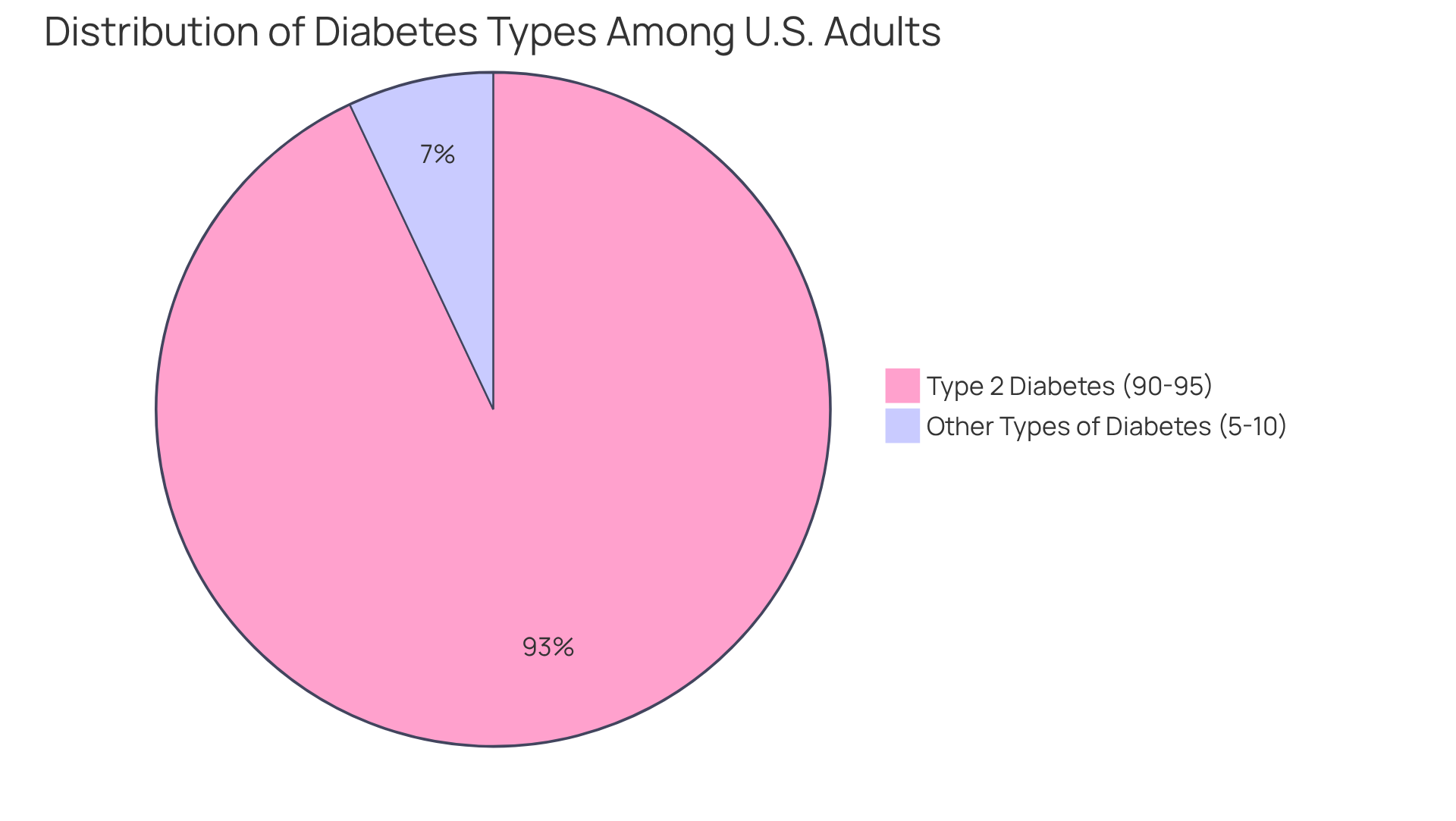
Majority of Type 2 Diabetes Cases Occur in Adults Aged 45 and Older
Among adults aged 45 and older, the prevalence of Type 2 Diabetes is notably high, leading us to consider about what percent of US adults diagnosed with diabetes have type 2? As we age, the likelihood of developing this condition increases, influenced by various factors such as lifestyle choices, obesity, and metabolic changes. For instance, approximately 27.3% of adults aged 60 and older experience total blood sugar disorders, underscoring a significant correlation between age and the occurrence of this condition. It's important for healthcare providers to understand these age-related risks so they can tailor effective resources and support for older adults.
Effective initiatives aimed at preventing diabetes-related issues in elderly groups have shown the benefits of lifestyle changes. Encouraging physical activity and nutritious eating can be transformative. These initiatives have demonstrated potential in postponing the onset of the disease, particularly among those at high risk. Additionally, addressing risk factors like obesity is crucial. Individuals with obesity show a prevalence of 24.2%, compared to just 6.8% in those with normal weight.
Healthcare specialists recommend a comprehensive strategy for diabetes management in elderly individuals, which includes:
- Routine screenings
- Personalized care plans that consider personal conditions and comorbidities
By focusing on these strategies, healthcare providers can significantly enhance health outcomes and improve the quality of life for older adults living with or at risk for Type 2 Diabetes. Remember, you're not alone in this journey, and support is available every step of the way.
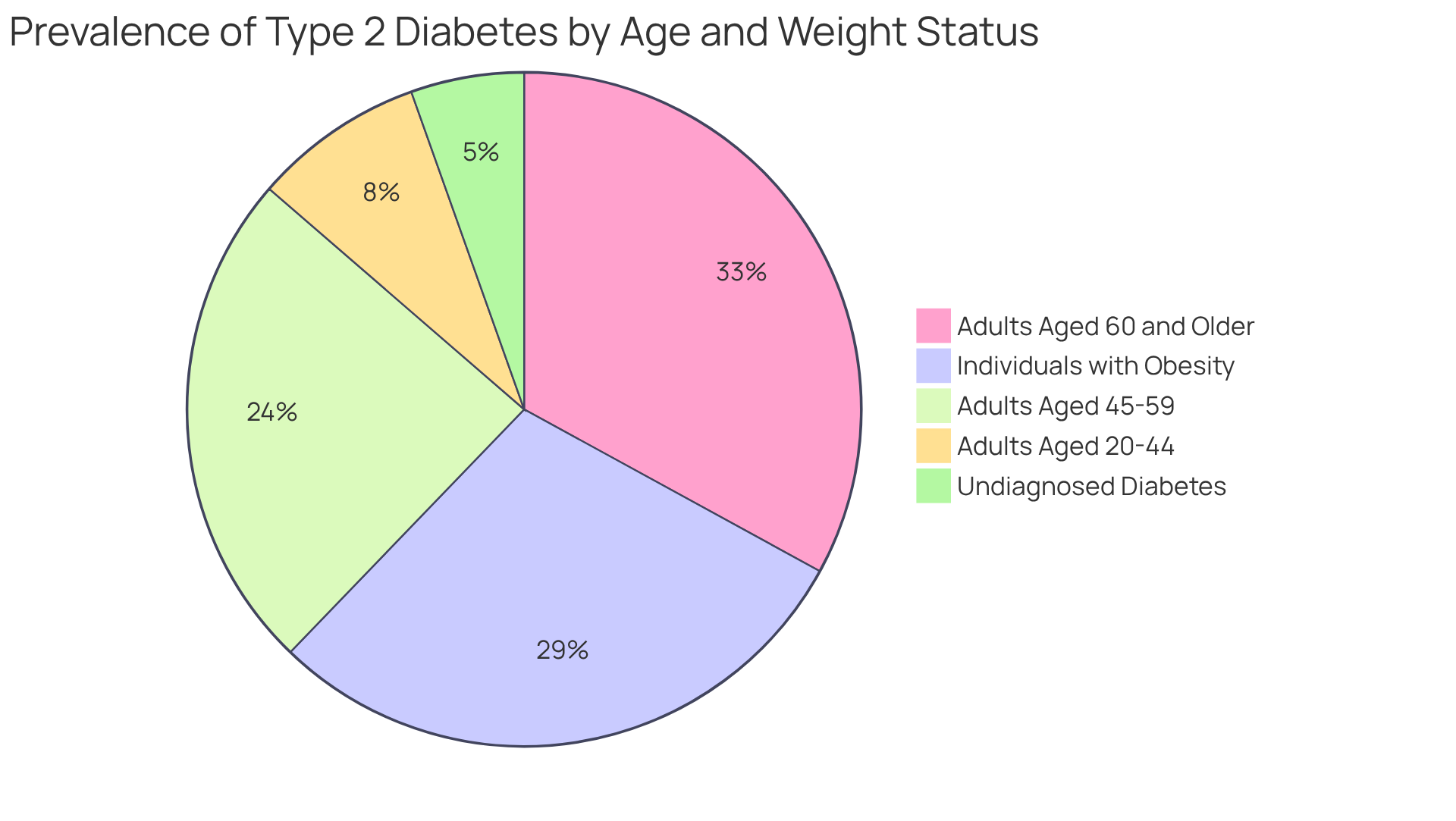
Increasing Incidence of Type 2 Diabetes Among Younger Adults
Recent studies highlight a concerning rise in Type 2 Diabetes diagnoses among younger adults, particularly those aged 18 to 44. From 2002 to 2018, the annual diagnosis rate for Type 2 Diabetes in this age group doubled from 9 to 18 per 100,000, reflecting a 5% annual increase. It's understandable to feel alarmed by these numbers, especially when considering the key factors contributing to this trend:
- Sedentary lifestyles
- Poor dietary choices
- Escalating obesity rates, which climbed from 32.7% to 40.9% during the same period
Furthermore, the prevalence of the disease among young adults increased from 3% to 4.1%.
These statistics underscore the urgent need for focused education and preventive strategies to address this condition in younger populations. Effective prevention programs have shown that community-informed, culturally appropriate public initiatives can significantly reduce the risk of diabetes, especially among high-risk groups like Black, Hispanic, and Asian/Pacific Islander young adults. By fostering awareness and advocating for healthier lifestyle choices, we can work together to confront the rising prevalence of Type 2 Diabetes. Remember, you're not alone in this journey; we can enhance health outcomes for future generations by supporting one another and making informed choices.
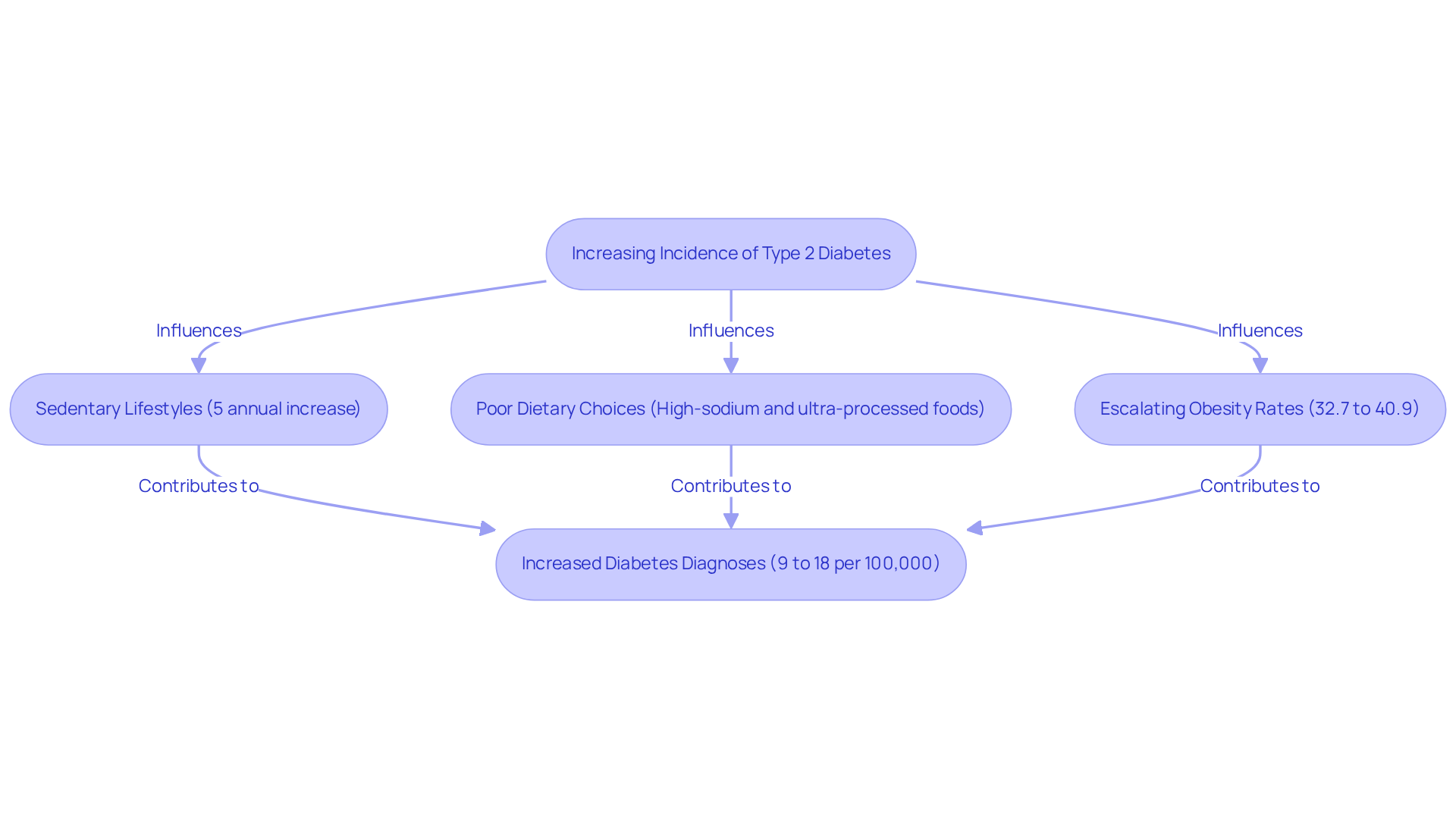
Type 2 Diabetes Contributes to Over $327 Billion in Annual Healthcare Costs
Type 2 Diabetes brings a significant economic burden, contributing to around $412.9 billion in annual healthcare costs in the United States. This staggering figure includes direct medical expenses—hospitalizations, outpatient care, and medications—which alone account for approximately $306.6 billion. Additionally, indirect costs from lost productivity and premature mortality add another $106.3 billion to the total. It’s understandable to feel overwhelmed by these numbers, especially since individuals diagnosed with this condition incur healthcare expenses that are 2.6 times higher than those without the illness.
This financial pressure underscores the urgent need for effective management resources and support systems for diabetes-related issues. At T2DSolutions, we recognize the challenges you face, and we aim to alleviate this burden. We provide comprehensive educational resources, community support, and actionable strategies tailored specifically for newly diagnosed patients. You're not alone in this journey; we ensure you have the tools necessary to manage your condition effectively and navigate the path ahead with confidence.
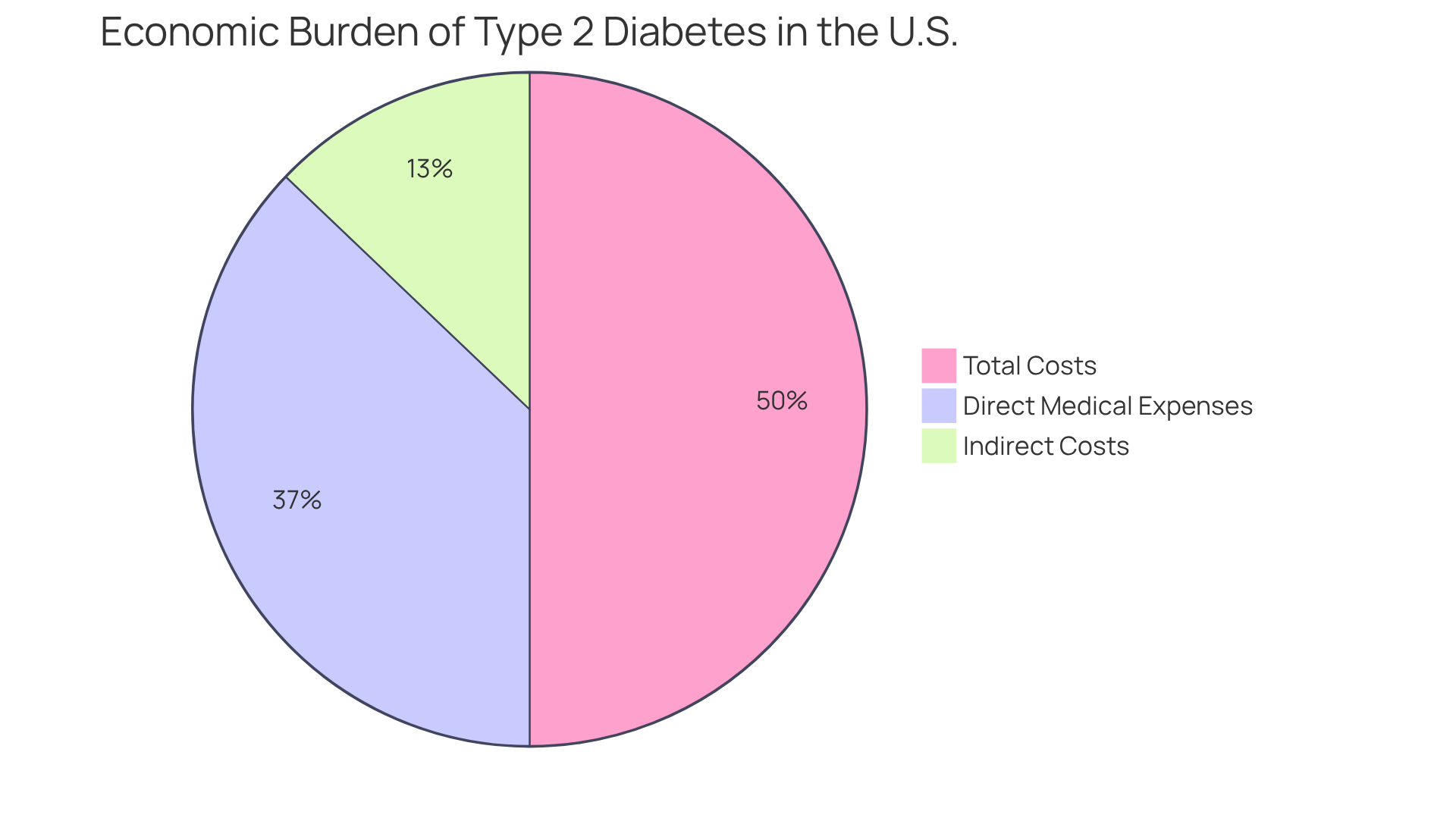
Obesity Affects Nearly 80% of Adults Diagnosed with Type 2 Diabetes
Did you know about what percent of us adults diagnosed with diabetes have type 2, which is approximately 65%, also struggle with obesity? This statistic highlights a significant relationship between these two conditions. It's understandable to feel overwhelmed by this connection, but it emphasizes the importance of effective weight management strategies as a crucial part of diabetes care.
Successful weight management programs often incorporate comprehensive lifestyle changes. These include balanced dietary plans and regular physical activity, which can lead to substantial improvements in health outcomes. Nutritionists emphasize that addressing obesity not only aids in managing blood sugar levels but also reduces the risk of developing related complications.
At T2DSolutions, we provide valuable resources and community support to help you navigate these challenges. Remember, by focusing on sustainable lifestyle changes, you can improve your overall well-being and gain better control over your diabetes. You're not alone in this journey, and we're here to support you every step of the way.
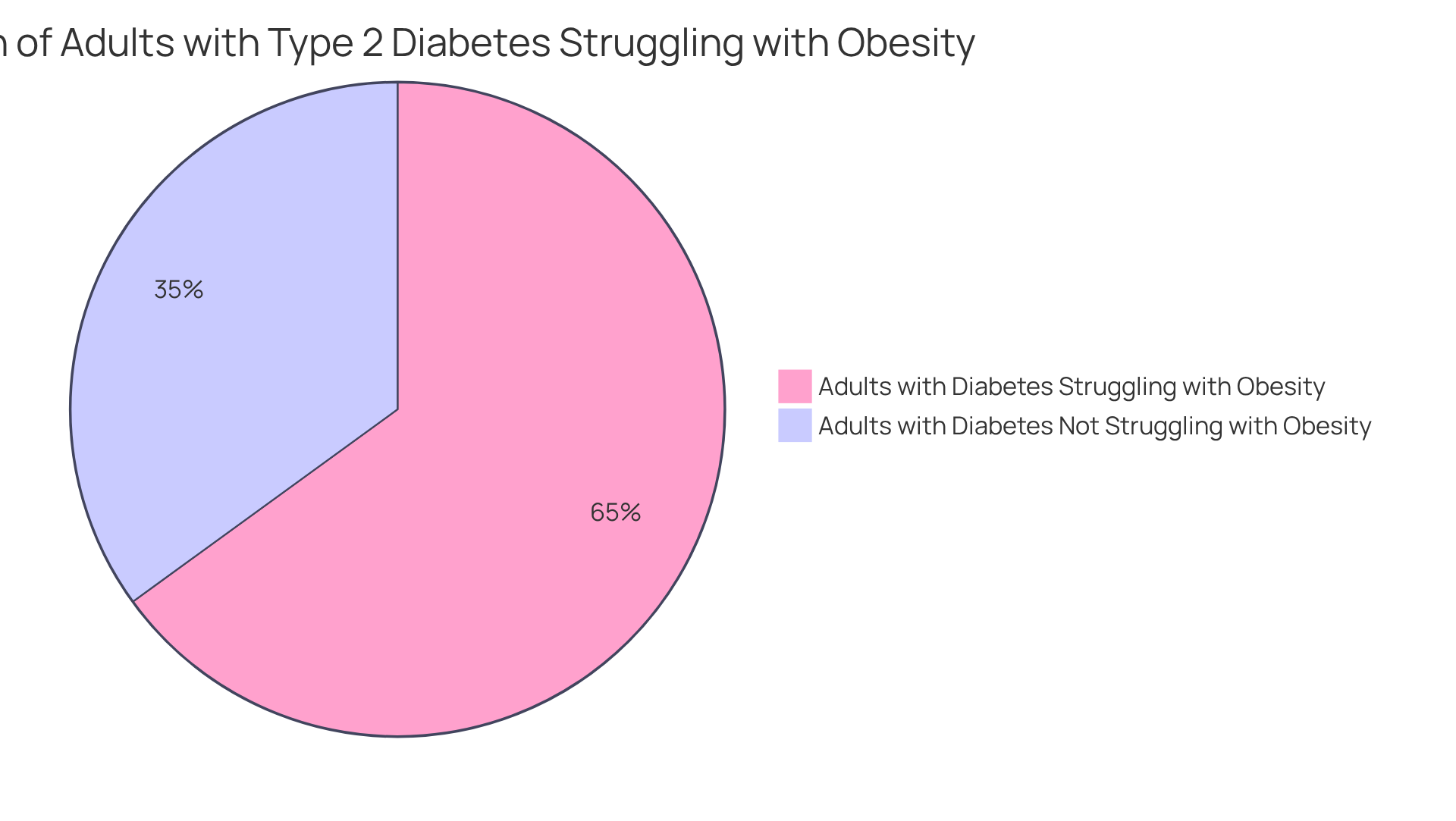
Lifestyle Changes Can Reduce Type 2 Diabetes Risk by Up to 58%
It's understandable to feel concerned about your health, especially when it comes to diabetes. Studies indicate that making lifestyle adjustments can lower the likelihood of developing Diabetes 2 by as much as 58%. By adopting a healthier diet, increasing physical activity, and maintaining a healthy weight, you can take meaningful steps toward prevention. You're not alone in this journey; many have found success through these changes.
Focusing on these lifestyle modifications not only lowers your risk but also enhances your overall well-being. Imagine feeling more energetic, healthier, and in control of your life. We are here to support you every step of the way as you make these important changes. Remember, every small step counts, and together, we can create a healthier future.
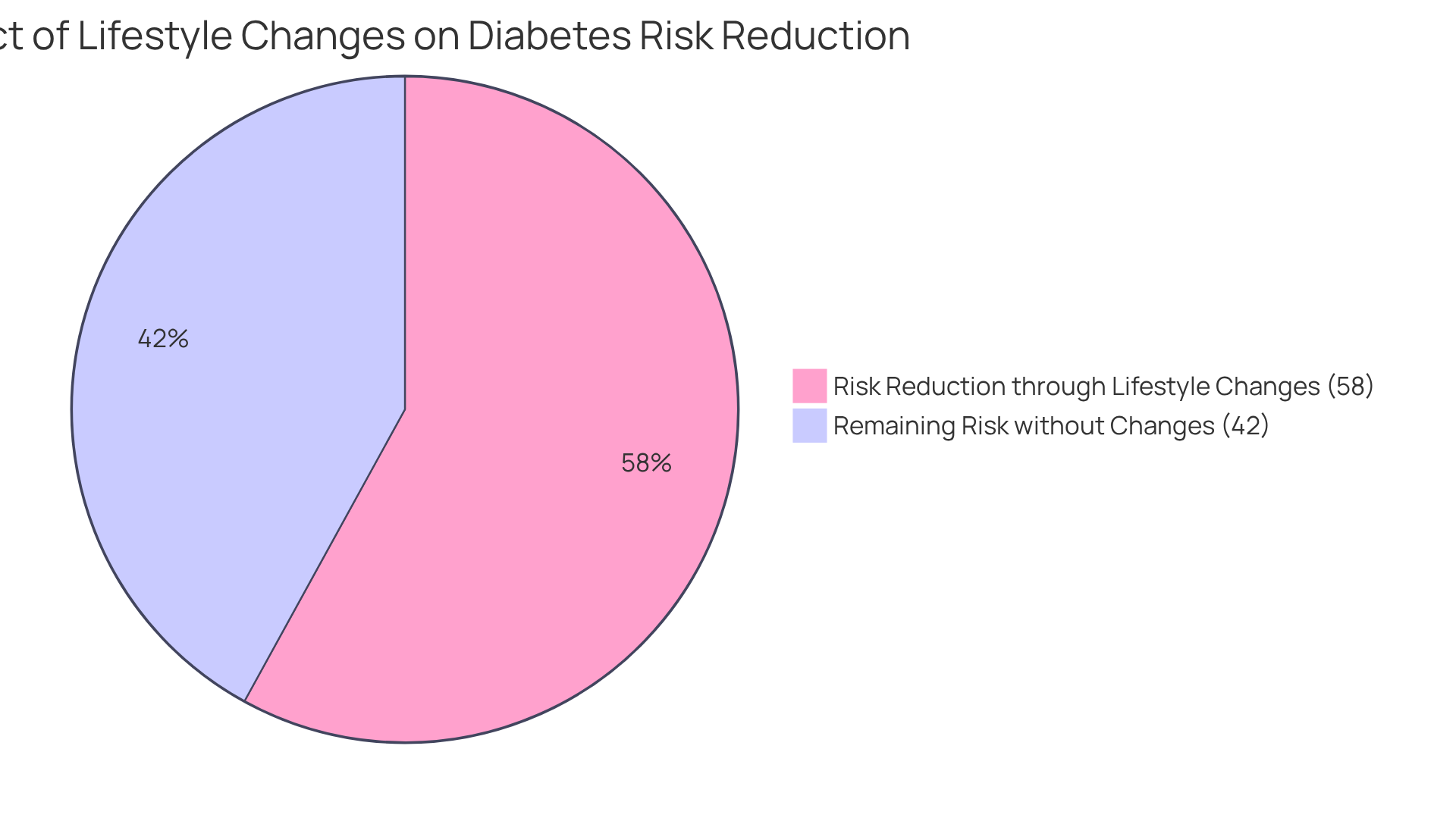
Higher Rates of Type 2 Diabetes Found in Minority Populations
Type 2 Diabetes is notably more prevalent among minority populations, with African Americans experiencing a rate of 13.2%, Hispanics at 12.8%, Native Americans facing even higher rates, reaching up to 14.5%, and Asians at 9.0%. These disparities are closely linked to socioeconomic factors, including restricted access to medical care, lower wellness literacy, and cultural influences that impact dietary choices and lifestyle habits.
It's understandable to feel concerned about these statistics. Public health officials emphasize that addressing these disparities is crucial for improving health outcomes. For example, Eliza Siegel highlights that systemic racism and socioeconomic disadvantages greatly increase vulnerability to complications among these groups. Significantly, 40-60% of disparities related to the condition can be linked to socioeconomic status alone, underscoring the necessity of addressing these factors in management.
You're not alone in this journey, and successful community health initiatives have emerged to tackle these challenges. Programs that concentrate on culturally tailored education for managing blood sugar levels have shown promise in enhancing self-management skills and promoting healthier lifestyles. Involving families and peers in managing the condition can also cultivate a supportive atmosphere, which is crucial for effective care.
Furthermore, the economic burden of this condition is substantial, with total costs estimated at $413 billion in 2022, highlighting the urgent need for targeted interventions. By emphasizing education and community assistance, we can strive to diminish the gaps in managing blood sugar among various ethnic groups, ultimately resulting in better health outcomes for all impacted individuals. We are here to support you every step of the way.
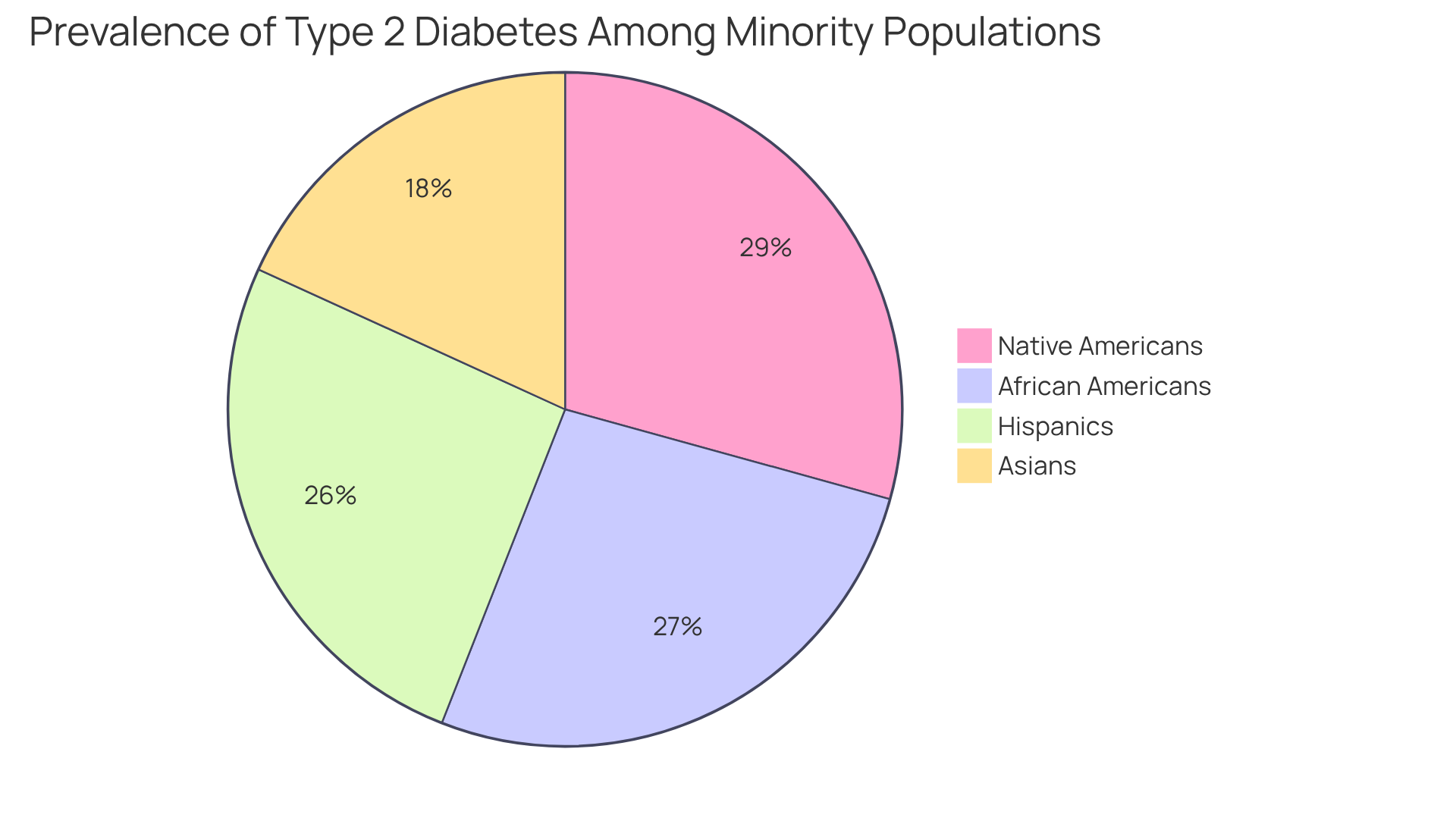
Type 2 Diabetes Increases Risk of Heart Disease and Stroke
If you or a loved one is living with Type 2 Diabetes Mellitus, it's important to know that this condition can significantly increase the risk of heart disease and stroke. Studies show that individuals with diabetes face a markedly higher likelihood of cardiovascular complications. Elevated blood sugar levels can damage arteries, leading to plaque buildup and narrowing of blood vessels—serious precursors to heart conditions. In fact, those with diabetes are at twice the risk of developing heart disease compared to those without.
Managing your diabetes effectively is crucial for reducing these cardiovascular risks. This involves:
- Maintaining optimal blood sugar levels through a balanced diet
- Engaging in regular physical activity
- Following prescribed medications
Aim for at least 150 minutes of exercise each week; this can greatly enhance your cardiovascular health and overall well-being. Additionally, managing your weight and reducing stress are vital components of a comprehensive approach to blood sugar management.
Recent studies highlight the strong connection between diabetes and cardiovascular health, emphasizing the need for continuous monitoring and proactive management strategies. Healthcare specialists recommend regular wellness examinations, including assessments of blood pressure and cholesterol levels, to catch potential cardiovascular issues early. By prioritizing these wellness measures, you can take meaningful steps toward reducing your risk of heart disease and improving your quality of life.
Remember, you're not alone in this journey. We are here to support you every step of the way. Taking action now can lead to a healthier future.
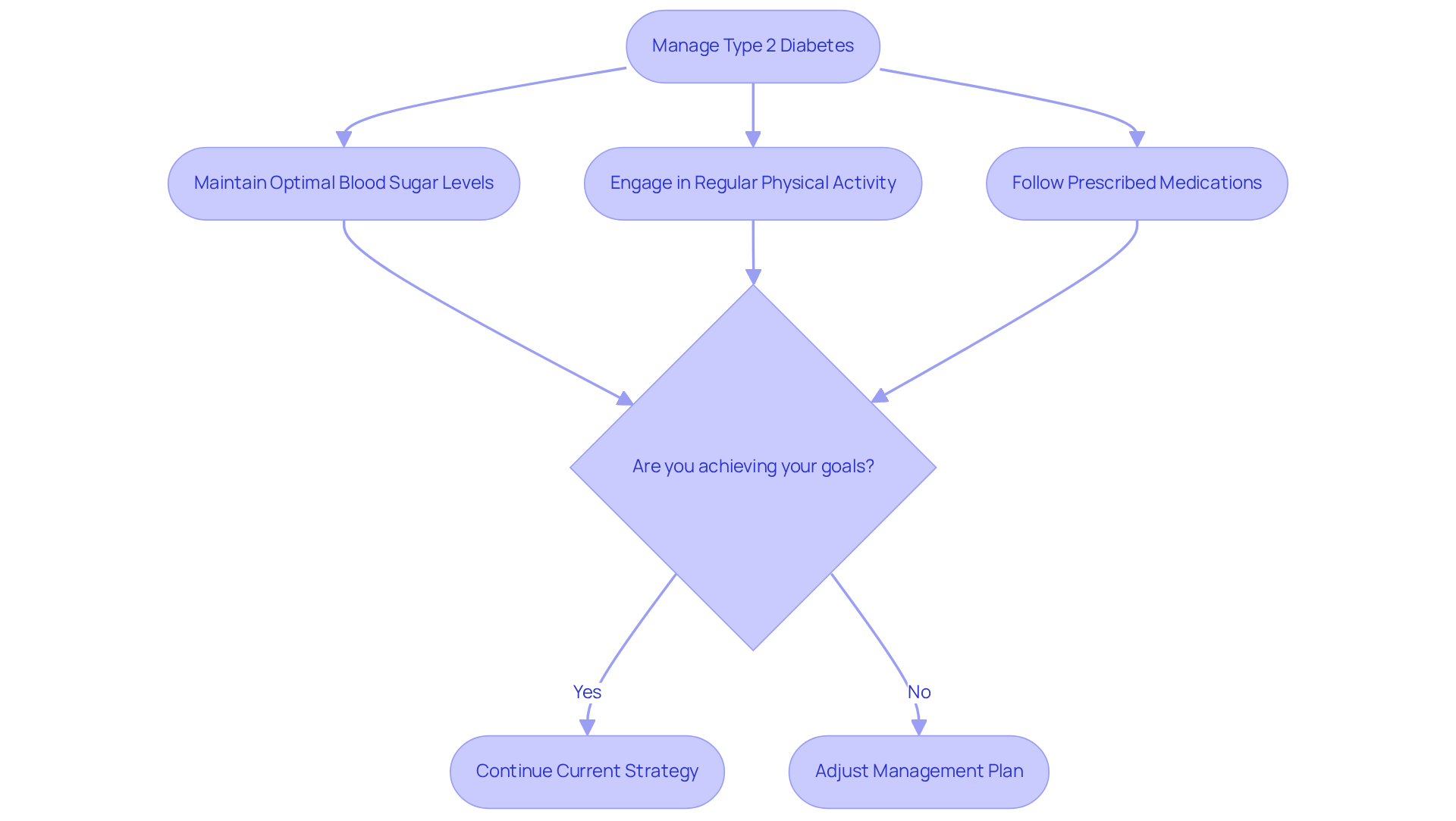
Community Support and Resources Are Vital for Managing Type 2 Diabetes
Community support and resources are essential in managing Type 2 Diabetes. It's understandable to feel overwhelmed, but participating in support groups, educational programs, and community health initiatives can provide the motivation and information you need on your health journey.
T2DSolutions fosters a sense of community by connecting you with others who share similar experiences and resources. Together, we can promote a collaborative approach to diabetes management, reminding you that you're not alone in this journey. We are here to support you every step of the way.
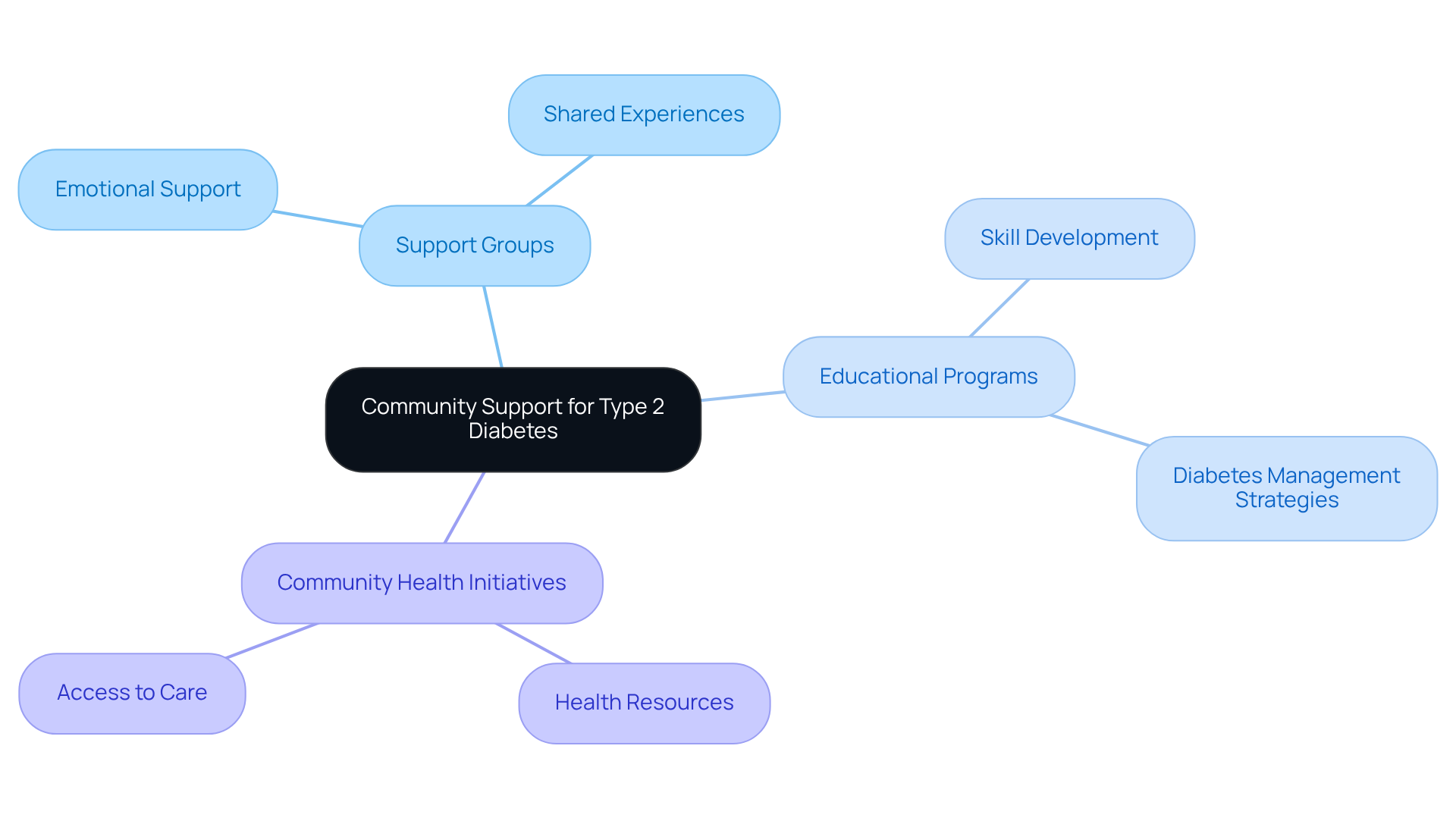
Conclusion
Approximately 90-95% of adults diagnosed with diabetes in the United States have Type 2 Diabetes. This statistic highlights a pressing need for effective management strategies and community support. With nearly 38 million Americans affected, the necessity for reliable information and comprehensive care is more crucial than ever. Providing targeted resources and education empowers individuals in navigating their health journeys.
This article explores various aspects of Type 2 Diabetes, including its prevalence among different age groups, the rising incidence in younger adults, and the economic burden it places on the healthcare system. It emphasizes the critical role of lifestyle changes in reducing the risk of developing the condition and managing its effects. It's important to note that nearly 80% of adults diagnosed with this condition also struggle with obesity, which complicates their health outcomes even further.
Addressing the challenges posed by Type 2 Diabetes requires a collective effort. By fostering an environment where individuals can share experiences and strategies, the journey toward better health becomes more manageable. Engaging with resources like T2DSolutions can provide the necessary tools to navigate this complex condition effectively. Together, by prioritizing education, lifestyle changes, and community support, we can achieve a healthier future for those affected by Type 2 Diabetes. You're not alone in this journey, and we are here to support you every step of the way.
Frequently Asked Questions
What is T2DSolutions?
T2DSolutions is a platform dedicated to empowering individuals and families affected by Type 2 Diabetes through comprehensive education and resources, including tailored dietary plans, workout schedules, and updates on medical studies.
Why is community involvement important in managing Type 2 Diabetes?
Community involvement is crucial because research shows that individuals with strong community support experience better health outcomes, helping them navigate the complexities of care more effectively.
What percentage of US adults diagnosed with diabetes have Type 2 Diabetes?
Approximately 90-95% of adults diagnosed with diabetes in the United States have Type 2 Diabetes.
What is the economic burden of diabetes in the United States?
The total medical costs and lost work for people diagnosed with diabetes amount to $413 billion.
What age group is most affected by Type 2 Diabetes?
The prevalence of Type 2 Diabetes is notably high among adults aged 45 and older, with approximately 27.3% of adults aged 60 and older experiencing total blood sugar disorders.
What lifestyle changes can help prevent Type 2 Diabetes?
Effective lifestyle changes include improved diet and increased physical activity, which can significantly reduce the incidence of Type 2 Diabetes.
What strategies do healthcare providers recommend for managing Type 2 Diabetes in older adults?
Recommended strategies include routine screenings and personalized care plans that consider individual conditions and comorbidities to enhance health outcomes for older adults living with or at risk for Type 2 Diabetes.



